Part I: Innovation First
DJI is proud to be considered the world’s leading civilian drone technology company today, but we don’t take our success for granted. The release of the Phantom in 2012 arrived as the quintessential consumer drone, even so far as seeing its one-of-a-kind design in film and television. From the outside, many may view DJI as an overnight success, breaking barriers through the revolutionary Phantom. But few know about all the years and steps that it took to get there.
The truth of the matter is this – yes, we made and defined the modern drone. But before that, we invented the building blocks that made it possible. The story of developing these components speaks to DJI’s core philosophy: The audacity to make it first, the drive to make it best, and the vision to make it accessible to all.
ViewPoints sat down with four developers who joined the company as early as 2008 to learn more about the principles that helped to define what we think of in modern drones. Peter Tao, Aaron Shi, Jerry Yu, and Paul Pan are members of DJI’s R&D team, who used a bold startup mentality to create the modern drone. And to achieve that, they needed to invent all the parts that made it possible.

Creating an Industry for a New Audience
DJI was founded in 2006 like any classic startup: in a college dorm room. Then-student Frank Wang decided to use this company to solve a quintessential problem about remote-controlled flight: it was far too difficult for anyone other than dedicated enthusiasts to do.
“I didn’t know how big the market could be. Our idea was to just make the product, feed 10 to 20 people, and have a team,” Frank said in an interview with Forbes in 2015.
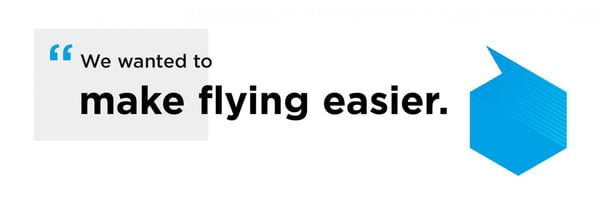
Remote-controlled flight in 2006 did not include the drones we see today, as they didn’t even exist. Instead, unmanned-aerial flight (UAV) existed mostly in radio-controlled airplanes and helicopters. The enthusiasts who flew them wanted to replicate real flight, meaning that these early UAVs were far from easy to control.
“We saw a real need of providing a reliable flight experience to an underserved type of user: the kind who doesn’t normally know how to fly,” said Peter Tao, who joined the company in 2008, even before DJI started selling any products. “From this point, putting the right easy-to-use tools in their hands was our job.” The first step, naturally, was looking at the flight controller.
The brain of the UAV, the flight controller receives the operator’s stick commands and tells the parts of the helicopter how to move. Think of it as a form of autopilot that makes flying much easier and reliable. Without a flight controller, keeping an RC helicopter stable in the air required a dedicated skillset. The problem, however, was flight controllers at the time required full assembly by experienced hands. This time-consuming process received a 21st-century solution in the compact, ready-made DJI XP Flight Controller. It was ready-built and provided the reliable and stable performance needed to fly. The XP series came as the first product of its kind, opening the world of UAVs to more people.
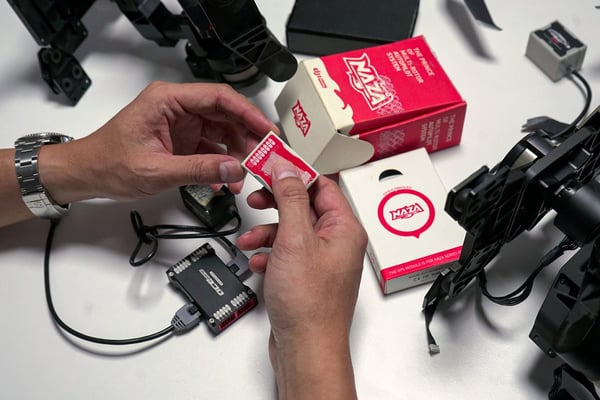
“The XP let us help anyone achieve and enjoy the experience of flight,” explained Jerry. “And if anyone can fly, think about what could be achieved, like capturing beautiful aerial pictures and video.” While RC helicopter purists criticized the XP, Frank and his small team of engineers sold 20 monthly units through word of mouth and on RC online forums.
How the Perfect Drone Should Look
With the task of simplifying flight achieved, DJI pushed with more problems to solve. Even as scale models, RC helicopters were still relatively large and heavy, which was intimidating to new users, and potentially dangerous in situations, like flying near people. Was a better UAV design the next step?
The solution was to replace a single helicopter propeller with a coordinated group of smaller ones. Multiple propellers would allow for smaller, lighter, and quieter motor design since the work of lifting the airframe would be shared across each one. And for users whose primary demand was more responsive flight control, multiple propellers would make it easier to turn, spin, and tilt the aircraft as needed. With these benefits in mind, a multi-rotor UAV shape was a natural choice. The next question: how many rotors?
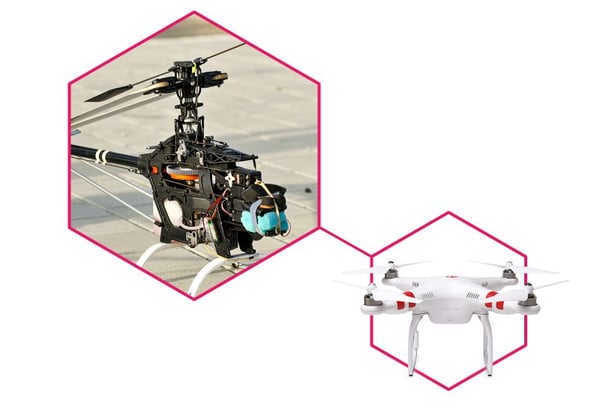
“We could have made drones that were performing much better with eight rotors, which would appeal to professionals with deeper pockets, but that wasn’t part of the plan,” explained Aaron. After all, DJI was focused on creating an experience for everyday people. A drone with four rotors would achieve similar levels of reliability and safety, but it would be simpler, lighter, and have a longer flight time. DJI reflected this with their very first drone product, the Flame Wheel in 2011. This came as a Kit to Assemble – inside the box was every part needed to assemble a reliable drone.
At a time when users were on their own to find and put together every piece of the drone, the Flame Wheel was a novel solution. It brought the drone industry one step closer to a product everyone could use. However, assembly, soldering, and programming were still required. It would be one more year until DJI would introduce a drone that needed no assembly at all.
User-Friendly and Ready for Takeoff
2012 was the year of the Phantom 1, the world’s first capable ready-to-fly consumer drone, with no assembly required. It was compact, streamlined, and, most notably, discreet. Unlike drones at the time, the Phantom had no exposed wiring or controls. “The Phantom 1 represented simplicity and accessibility. It embodied the idea that flying is for everyone, which highlights an emphasis on making products with taste,” explained Aaron. With the Phantom 1, the idea of a consumer drone market was born.
If one day, the Phantom 1 could take photos and videos, the camera would need to be steady to take smooth footage. The problem, as usual, was that technology of that size didn’t exist.
While there were cameras that were small and compact enough to fit in a drone, it came with two key limitations. First, it wasn’t integrated into the flight system, meaning that the only option was to set a small action camera on timed interval photos or hit the record button, fly around for a few minutes while shooting blind, and hope for the best results. Second, cameras mounted to the drone would follow its movements completely. Any time the drone pitched forward or shook in the wind, the camera would do the same, creating shaky video and blurry photos.
“The technology we needed for a proficient camera system of such a small size just didn’t exist,” said Peter. “We simply had to create an all-around solution ourselves.”
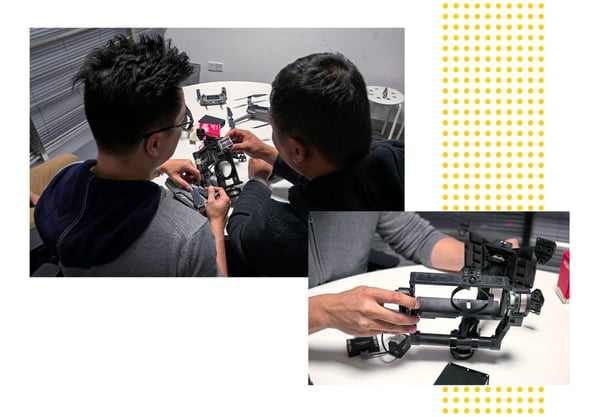
The pursuit of this solution gave rise to the Zenmuse motorized gimbal, a breakout for DJI in a new category: professional camera stabilizers. Users could mount their DSLR camera onto the Zenmuse 15, which would attach to a drone. The result was a smooth aerial shot, which was only available with a cameraman in a helicopter. With the Zenmuse, DJI was also able to develop consumer gimbals, which no other company was doing at all. This technology also made its way in DJI’s next drone.
When the R&D team unveiled the Phantom 2 Vision+, they introduced DJI’s first onboard gimbal camera. Developed completely in-house, the onboard three-axis gimbal was miniaturized for the Phantom, and was made at a tenth of the cost of the Zenmuse 15. “We believe that to truly succeed in the goal of giving an ideal flight experience to all, we would need dedicated product development over as many aspects of the product as possible,” shared Peter.
Suddenly, everyday users could make professional-quality aerial footage with three-axis stabilization and camera control. They could also watch a live feed of all the footage through Vision, the first DJI mobile app.
Aerial Perspectives for Multiple Industries
As the Phantom series took off in the drone market, the user base branched out across several professions, hobbies, and use cases, from real estate agents to wedding photographers. It was abundantly clear the drone user profile was diversifying, and therefore the drone itself would have to evolve accordingly.
“Working with DJI drones almost instantly changed my career path,” said Mike Bishop, a professional drone pilot and filmmaker who has been using DJI drones since the Phantom 1 in 2013.
“Before using drones, it was much more common to rent a helicopter for a shoot, which was so much more expensive. Drones are easily one of the most effective ways to get a huge amount of production value in a very efficient way.”
With Phantom creating momentum for filmmakers to make blockbuster aerial shots at a fraction of the cost, DJI announced an upgraded version of an aerial imaging drone – the Inspire 1.
“2014 was the perfect time to introduce the Inspire 1 because that’s when a solution was needed for professional aerial imaging,” said Peter. With the ability to change the camera, the Inspire 1 became a dedicated choice for professionals across multiple industries.
Empowering Consumers with Choice
DJI introduced the Phantom 3 in 2015, offering different versions for different types of users. “The Standard, Advanced, and Professional models of the Phantom 3 gave users the critical aspect of choice,” explained Paul. “Instead of being just the next Phantom, these three versions allowed users to get the right drone for them, based on their needs and ambitions.” At a time when the consumer drone market suddenly became popular, the Phantom 3 arrived as a mature product to meet every user’s needs.
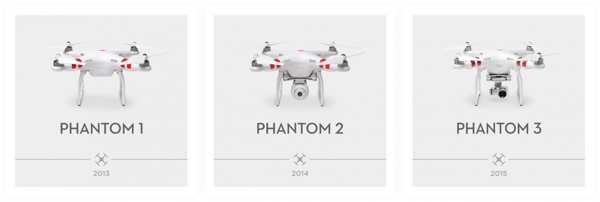
While the Phantom 3 solidified DJI’s place atop the drone industry, it came after a decade of relentless innovation. From a simplified flight controller to a ready-to-fly drone that can capture incredible images from above, the company consistently took steps to deliver ground-breaking technology to solve a problem.
From Hardware to Software
After DJI achieved advancements in hardware, what was next?
Several collaborations with professionals and businesses showed that drones were poised to transform industries. Drone-based startups were emerging in the United States, offering a glimpse into the future. More and more people wanted to use consumer drones, so a need for simplifying the user experience grew. With these all in mind, DJI looked to revolutionize the industry in another way – with its software.

